Capital Maritime, based in Greece, has found employment for the first of five ex- Hanjin Shipping container vessels acquired in March in a BNP Paribas auction. The 113,412gt/2011-built Hanjin China (above), which was renamed Athenian by Capital Maritime, has been chartered to Hapag- Lloyd for a period of four to six months at a daily rate of $33,000. Three of the remaining four vessels were delivered to the Greek owner in May with the fourth scheduled to arrive in June. The five 9,954 TEU capacity ships, which also include the 113,412gt Hanjin Korea, 113,515gt Hanjin Netherlands plus the 113,412gt Hanjin Spain and Hanjin United Kingdom, were built by Samsung Heavy Industries with the first delivered in 2010 and the rest completed in 2011.
COSCO Shipping’s 141,823gt/2011 built and 13,092 TEU capacity Neopanamax containership COSCO Development became the largest vessel both in dimension and capacity to transit the Expanded Panama Canal since it was inaugurated in June 2016 on 2nd May (above). The 366m long and 48.20m beam giant began her voyage in Asia and later became the largest ship to arrive on the US East Coast. The vessel is deployed on the new OCEAN Alliance weekly South Atlantic Express (SAX) service, connecting Asia-US East Coast ports via the Panama Canal. The SAX service is comprised of 11 vessels ranging in size from 11,000 to 13,000 TEUs. The Alliance includes China COSCO Shipping, Orient Overseas Container Lines (OOCL), CMA CGM Group and Evergreen, which are among the Panama Canal’s top customers by volume. Containerships represent some 43% of traffic through the new locks, followed by liquefied petroleum gas (LPG) carriers and liquefied natural gas (LNG) carriers, which represent around 29.1% and 8.3% respectively.
Eimskip of Reykjavik has reached an agreement for the financing of the construction of two 2,150 TEU container vessels ordered in January 2017. The loan, secured by China Export & Credit Insurance Corporation (Sinosure), is for an 80% financing of the contract price of the vessels with a 15 year tenor in Euros taken upon delivery. Under the shipbuilding contract signed with China Shipbuilding Trading Company Limited and Guangzhou Wenchong Shipyard, the containerships are each priced at around $32m. The order was subject to financing and that has now been lifted.
CMA CGM’s 91,410gt/2005 built CMA CGM Otello (above seen in Southampton) arrived at Jakarta, Indonesia on 23rd April 2017 and became the largest container vessel to call in the country at the Jakarta International Container Terminal. The occasion also celebrated her impending maiden voyage for the industry’s first direct service from Indonesia to the U.S.A. on 24th April.
Hapag Lloyd’s the 142,295gt/2013 built Antwerpen Express became the largest container vessel to call in Canada when she visited GCT Deltaport, located in the Port of Vancouver on 5th May (above). The 13,200 TEU ship has been deployed in THE Alliance’s Transpacific mainline West Coast PN3 service.
Korea Asset Management Corp. (KAMCO) was set to take over 20 vessels worth 390 billion Won ($344 million) owned by six shipping firms in May. According to industry sources, KAMCO was to sign a contract to acquire 20 container and bulk carriers with six shippers including SM Line Corp., Korea Shipping Co., Korea Line Corp., Namsung Shipping Co., Dooyang Limited and Pan Ocean Co. on 15th May. Of the 20 vessels, 10 were previously owned by the now-defunct Hanjin Shipping. KAMCO will cover 230 billion Won or 60% of the total price of 390 billion Won, and the remaining 160 billion Won will be provided by the six seagoing liners. The state clearing house and six shippers will invest 390 billion Won in KAMCO Ship Investment Company who will establish 20 special purpose companies (SPC) and lend money to them, and the SPCs will take over the vessels that will be leased back to the shippers. With the fund, the fiscally embattled shippers can improve their financial health by paying off debts with high borrowing costs and switching from short-term to longterm loan.
The help from the South Korean government will ease financial troubles of the nation’s new container shipper SM Line who acquired major assets of Hanjin Shipping. The fledgling company can retain Hanjin Shipping’s key workers and operation system with the newly raised fund.
Maersk Line deployed its first 2nd generation and 20,568 TEU capacity Triple-E ship Madrid Maersk (above) on 27th April 2017. She called at the Port of Tianjin in China on her maiden voyage to work on the Asia- Europe service network. The Madrid Maersk is the first in a series of eleven 2nd generation Triple-E vessels and the first of the 27 vessels Maersk Line ordered in 2015 to enter service. Maersk Line will take delivery of the vessels until the end of 2018, replacing older and less efficient tonnage. The company has not taken delivery of own newbuildings since July 2015. Maersk Line’s remaining order book consists of ten 2nd generation Triple-E vessels, nine 15,226 TEU and seven 3,596 TEU container vessels. The order book corresponds to 11% of Maersk Line’s current fleet, a relatively small order book when compared to the industry’s order book of around 15%. The 214,286gt Madrid Maersk was delivered four years after the arrival of the first Triple-E vessel, the 194,849gt/2013 built Maersk Mc-Kinney Møller.
A.P. Moller-Maersk agreed in April to sell off Mercosul Line, its Brazilian container shipping subsidiary, in order to clear Maersk Line’s $4bn takeover of Hamburg Süd with the Brazilian competition authorities. Hamburg Süd’s ownership of Aliança Navegaçao, its East Coast South America (ECSA) cabotage and feeder subsidiary, would have given Maersk Line an 80% share of trade to Brazil as Maersk’s Mercosul currently has a 21% share and Aliança 59%. Potential buyers of the Brazilian flagship carrier, which owns four ships, each with a 2,500 TEU capacity, include CMA CGM, Mediterranean Shipping Company, Hapag-Lloyd, NYK Line and Cosco China Shipping. Maersk will still have an 18.5% share of global trade after the sale and a 59% share of trade to Brazil. In the first quarter of 2017 Maersk Line sent a total of seven Panamax vessels to ship recycling yards. Four of these containerships, between 19 and 21 years old, were sent to China. They are being recycled by Jiangyin Xiagang Changjiang Ship Recycl ing, a Lloyd’s Register certified facility which has agreed to full compliance with the Maersk Responsible Ship Recycling Standard (RSRS), according to Maersk. The remaining three vessels, the Sea Land Charger, Sea Land Eagle and Sea Land Racer, were sold to Alang, India. They are being scrapped by Shree Ram and Y.S. Investments also in accordance with the company’s RSRS.

AP Moller-Maersk delivered a first quarter profit of $253m, up 12.9% year-onyear, aided by higher earnings from Maersk Oil but offset by decreases in almost all other businesses including Maersk Line. Maersk Line however posted a first quarter loss of $66m, reversing from the profit of $37m in the year-ago period, as the carrier was hit by higher bunker fuel costs.
Mitsui O.S.K. Lines Ltd. (MOL) and Samsung Heavy Industries Co. Ltd (SHI) have been issued with an Approval in Principle (AIP) by DNV GL for their future design of a series of four LNG-powered 20,000 TEU containerships that have been under construction. MOL and SHI signed a deal for the series of containerships in 2015. The vessels were designed in anticipation of using LNG as fuel, in light of more stringent environmental regulations that will take effect in the coming years. At the construction stage, both companies developed a basic plan targeting vessels in service, performance evaluation, compliance with new regulations, and risk assessment (HAZID) in a joint study, and completed the basic design in March 2017. Design characteristics of the vessels include a suitable LNG fuel tank layout and design for ultra large scale containerships, a suitable LNG fuel supply system to ensure maximum engine power output for ultra large scale containerships plus dual-fuel engines that are capable of using either heavy fuel oil (HFO) or LNG. MOL positions this series of vessels as its environmentally advanced next generation ships. The first vessel in the series, the 210,678gt MOL Triumph, was delivered on 27th March 2017, and is capable of being converted to LNG fuel at a later date.
MOL’s latest behemoth that is the 192,672dwt, 210,678gt, 400m long, 58.80m beam & 20,170 TEU capacity containership MOL Triumph made her Solent debut on the afternoon of 11th May, inward bound to Southampton (above). She is powered by an 82,440kW MAN B&W G95ME engine and can operate at 24 knots (22 knots cruising speed). She entered service as the world’s largest capacity containership but the new Maersk Madrid superseded her in April. The MOL Triumph also became the largest container vessel ever to berth at a UK port.
MSC’s MSC Daniella was still being discharged in Colombo on 25th April following her fire at sea on 4th April. The 13,800 TEU capacity ship had been en-route to Suez from Singapore when the blaze erupted. Once all containers were removed the ship could proceed to a repair yard for inspection and repairs, which could take many weeks. Over 100 TEUs were destroyed in the fire. The cause may never be known but MSC suspects undeclared hazardous cargo.
NYK (Nippon Yusen Kaisha) Line, of Japan, the world’s eighth largest, and the biggest of the Big Three Japanese container carriers, posted a net loss of JPY265.7 billion (US$2.39 million) in the financial year ended 31st March 2017. The Japanese carrier made a profit of JPY18.2 billion in the previous year. Revenue in the 2016 fiscal year amounted to JPN1.92 trillion, down 15.3%.
P&O Ferries, although not exactly a regular in this column, announced on 18th April that it was to launch a new dedicated freight service between its Zeebrugge and Hull terminals from 3rd May. The ferry and logistics company has chartered the 5,067gt/2000 built and 118 metre long Elisabeth, a container ship which will make three round-trips per week. The new sailings complement P&O Ferries’ existing combined tourist and freight service between Hull and the Belgian port, with the two ships on the route undergoing an £8.5 million re-launch earlier this year. Zeebrugge is P&O Ferries’ main continental hub. Overseas exporters to Britain benefit from P&O Ferries’ dedicated freight routes from Zeebrugge to Teesport and Tilbury as well as Hull.
Port Of Felixstowe welcomed the first call of a new service connecting North Europe and Turkey on 8th April. Known as the ‘North Europe Turkey Express’ (NET), the new weekly service is jointly operated by Cosco Shipping and OOCL. The first call was made by the 25,715gt/2016 built and 1,924 TEU Delphis Finland (above). The new NET container service provides UK importers and exporters with greater choice and frequency to an important and growing market. As well as calls at Felixstowe, the new service also calls at Hamburg, Antwerp, Piraeus, Istanbul-Ambarli (Kumport), Gebze (Yilport), Izmir and Salerno. Cosco Shipping and OOCL are both members of the new Ocean Alliance which has chosen the Port of Felixstowe as the main UK hub for its main Europe to Asia services. The other members of the Ocean Alliance are Evergreen and CMA-CGM.
Rickmers Maritime has reached agreement with Navios Maritime Partners L.P. for the latter to acquire Rickmers Maritime’s entire containership fleet. The deal, worth about $113 million, will see Navios Partners acquire 14 container vessels from Rickmers Maritime through a wholly owned subsidiary, Navios Partners Containers Inc. Three of the container vessels are 3,450 TEU, and 11 are 4,250 TEU, making a total of 57,100 TEU. The average ship age is 9.5 years. Five of the 4,250 TEU ships were expected to change ownership on 15th May and these are employed on charters that have staggered expirations in 2018 and early 2019 at a net daily charter rate of $26,850. The acquisition, still subject to a number of conditions, is being financed through a $20 million equity investment by Navios Partners and a secured loan facility under discussion. In addition, a third party has an option to acquire up to 25% of the equity in Navios Partners Containers Inc., based on allocated cost.
SM Line has built up its new containership fleet in just four months from 4th January with 17 ships now on its books, 11 of which were former Hanjin Shipping vessels. These include eight 6,665 TEU capacity, two 8,586 TEU vessels (ex-Hanjin) plus two 5,936 TEU, a 4,253 TEU Panamax, two 1,600 TEU vessels plus one 1,118 TEU capacity feeder vessel. Above is the former Hanjin Shenzhen arriving from the East Gibraltar anchorage in April to be renamed SM Hong Kong. Ultimately these will all serve SM Line routes but, in the short term, some ships are being chartered out to companies such as MSC & MOL.
United Arab Shipping Company’s (UASC) 141,077gt/2011 built UMM Salal (above) ran aground off Port Klang, Malaysia, on 6th April but was successfully refloated on 7th April. The grounding occurred while the 13,500 TEU capacity containership was sailing from Port Klang to Khor Fakkan, United Arab Emirates, on the company’s Asia/Gulf Express 1 (AGX1) route. After being set free the ship continued to Khor Fakkan.

Yang Ming Line suspended share trading on the Taiwanese stock exchange on 23rd April until 4th May in an effort to reduce the carrier’s equity capital by more than 50%. Two weeks previously Yang Ming had reassured customers in an advisory notice that it hadn’t needed to ask vendors to modify terminal terms, much less default on its obligations to vendors. In the 3rd April communication, Yang Ming pointed to how its fourth quarter loss of $64 million was $89 million less than its third quarter loss, giving the carrier “a hopeful indicator of a reversal in the market.” Taiwan’s National Development Fund is taking a 6.39% stake in Yang Ming, giving the Taiwanese government a 36.5% stake in the carrier once the first round of recapitalisation is complete. Yang Ming expects that the deployment of additional ships with capacities of 14,000 TEUs will bring down slots costs and create fuel savings.
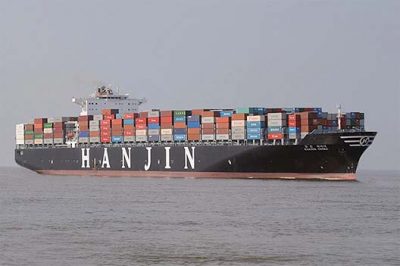
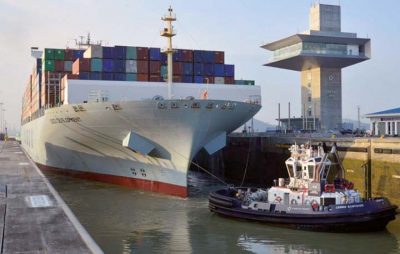
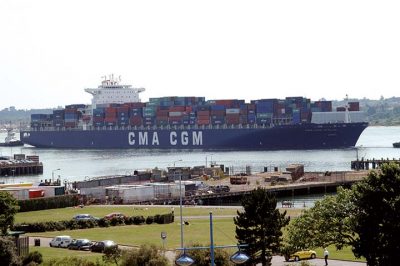
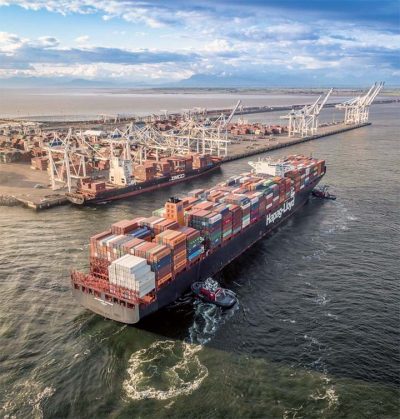
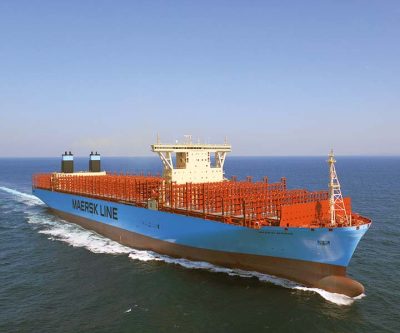
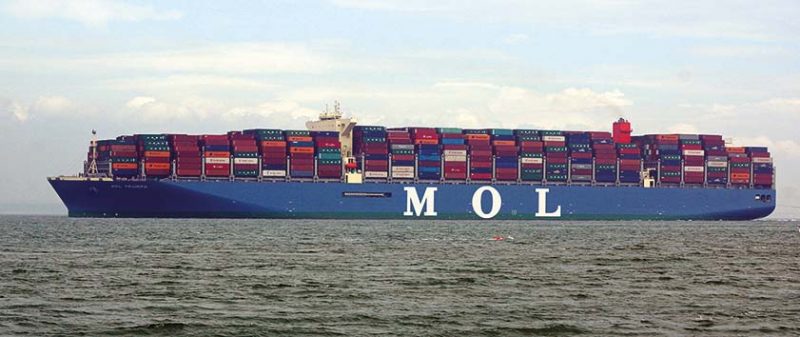
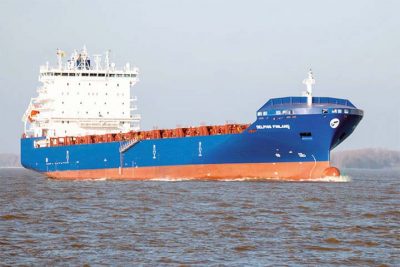

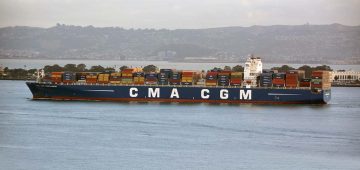



Comments
Sorry, comments are closed for this item